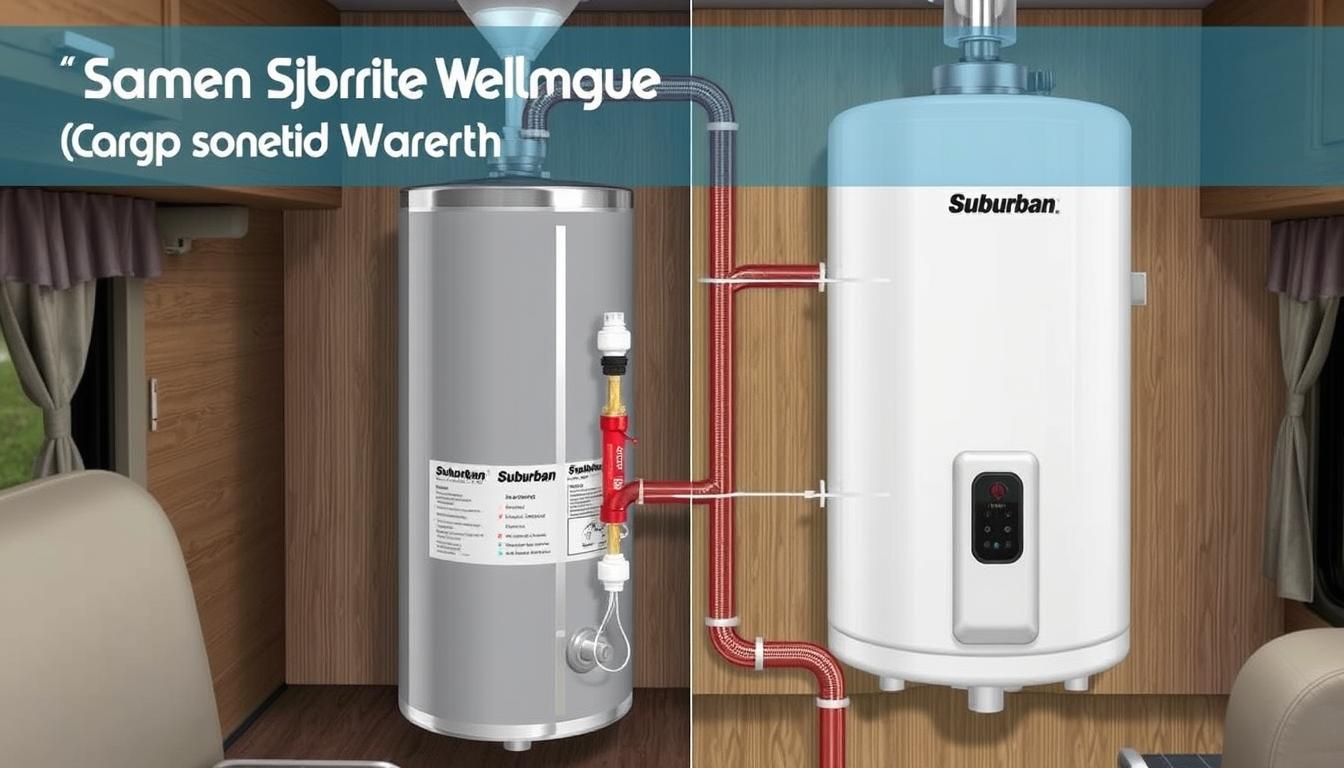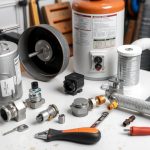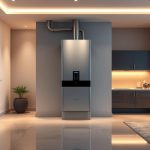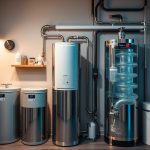Did you know that 90% of RV owners face hot water system issues? The Suburban RV hot water heater offers a reliable solution for travelers. It provides consistent comfort and convenience on the road.
A dependable hot water system enhances the camping experience. The Suburban SW6DE model excels as a top choice for mobile living. It works well as both a propane and electric water heater.
This guide explores RV hot water systems in depth. We’ll cover technical specs and maintenance strategies. Our insights will help RV owners make smart choices.
We’ll also explain tankless water heater technology. This knowledge empowers RV enthusiasts to improve their travel experience.
Key Takeaways
- Suburban offers versatile hot water solutions for RV travelers
- Understanding system components prevents unexpected breakdowns
- Proper maintenance extends water heater lifespan
- Gas and electric models provide flexible heating options
- Professional installation ensures optimal performance
Understanding Suburban RV Hot Water Heater Components and Operation

Suburban RV hot water heaters are crucial for recreational vehicles. They combine advanced engineering with practical functionality. These units provide reliable hot water through intricate design and innovative features.
Gas and Electric Operation Systems
RV hot water heaters use two main power setups: propane gas and 120V AC electric. The propane system offers quick heating without needing electricity. The electric element works well when shore power is available.
- Propane gas system: Ideal for boondocking and remote locations
- 120V AC electric element: Perfect for campground and RV park settings
- Hybrid models support both gas and electric operations
Temperature Control and Safety Features
Modern Suburban RV water heaters have advanced safety features. The thermostat controls water temperature precisely. This prevents overheating and potential damage.
| Safety Component | Function |
|---|---|
| Pressure Relief Valve | Prevents excessive pressure buildup |
| Anode Rod | Protects tank from corrosion |
Tank Capacity and Material Construction
The porcelain-lined tank is key in Suburban RV hot water heaters. This special coating resists corrosion and extends the unit’s lifespan.
“A quality porcelain-lined tank is the backbone of reliable RV water heating systems.” – RV Engineering Experts
Tank sizes usually range from 6 to 10 gallons. This fits various RV sizes and user needs. The strong build ensures lasting performance in different camping settings.
Common Troubleshooting and Maintenance Tips
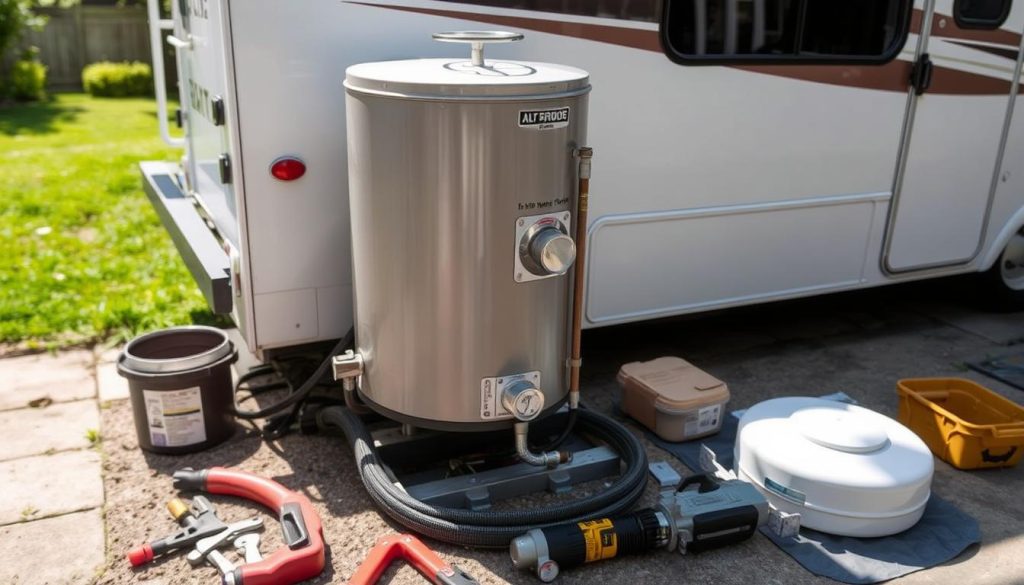
Your RV hot water heater needs regular care to work well. Suburban RV owners should learn key maintenance techniques. This helps ensure top performance and a longer lifespan for your water heating system.
Pilot light problems can affect your water heater’s function. If you have ongoing pilot light issues, try these steps:
- Check for gas supply interruptions
- Inspect thermocouple connections
- Clean the pilot light assembly
- Verify proper flame characteristics
Replace the thermocouple when your water heater can’t keep steady heat. Professional technicians recommend annual inspection to prevent unexpected failures.
“Regular maintenance prevents 80% of potential water heater malfunctions” – RV Maintenance Experts
Check the anode rod to stop tank rust. This rod protects your water heater’s inner parts. Replace it every two to three years for the best tank life.
Descaling removes mineral buildup that can lower efficiency. Winterizing is crucial for RV owners in cold areas. It protects the system from freeze damage.
| Maintenance Task | Recommended Frequency |
|---|---|
| Anode Rod Inspection | Every 2-3 years |
| Descaling | Annually |
| Winterization | Before Cold Season |
Regular upkeep keeps your Suburban RV hot water heater running smoothly. It prevents costly repairs and surprise breakdowns.
Installation and Replacement Guide for Suburban RV Hot Water Heater

Installing a new RV water heater demands careful planning and precision. It involves several critical steps to ensure safe operation. Proper installation guarantees efficient hot water in your recreational vehicle.
Gather all necessary tools and materials before starting. Good preparation is crucial for a successful water heater replacement.
Essential Tools and Materials
- Adjustable wrench
- Pipe wrench
- Teflon tape
- Screwdriver set
- Propane gas line connection kit
- Electrical wiring connectors
- Plumbing fittings
Step-by-Step Installation Process
- Disconnect existing power and gas sources
- Remove the old water heater carefully
- Clean the installation area thoroughly
- Inspect mounting brackets and replace if necessary
- Position new water heater
- Connect propane gas line with proper fittings
- Complete electrical wiring connections
Safety Considerations and Regulations
Following building codes is vital during RV water heater installation. Experts suggest these precautions:
- Verifying local building code requirements
- Using manufacturer-approved connection methods
- Double-checking all gas and electrical connections
- Ensuring proper ventilation around the water heater
“Always prioritize safety when working with gas and electrical systems in your RV.” – RV Maintenance Experts
Professional tip: If you’re unsure about any steps, consult a certified RV technician. This ensures proper setup and avoids potential safety risks.
Conclusion
Suburban RV hot water heaters are a top choice for reliable performance. They provide consistent hot water for comfortable travel. Proper maintenance keeps your system running efficiently and extends its lifespan.
Modern Suburban models use advanced tech to save energy. They deliver dependable hot water while conserving resources. Smart usage strategies help RV travelers make the most of their water heating systems.
Suburban’s customer support is a valuable asset for RV owners. Consider your travel needs, RV size, and usage when picking a water heater. Good maintenance greatly impacts system performance, ensuring hot water on all your trips.
Understanding your RV hot water heater is key to comfort and efficiency. Regular inspections and following manufacturer guidelines are crucial. This care helps you get the best from your Suburban heating system.
